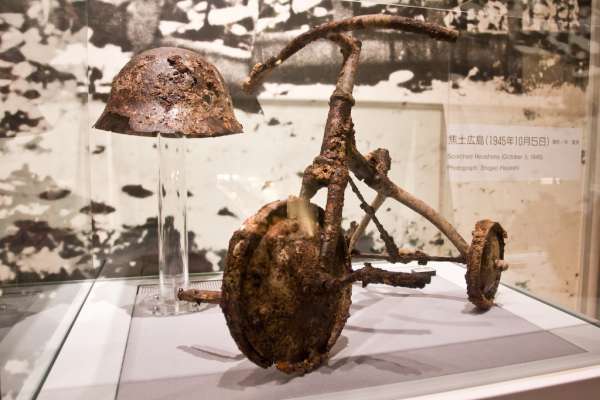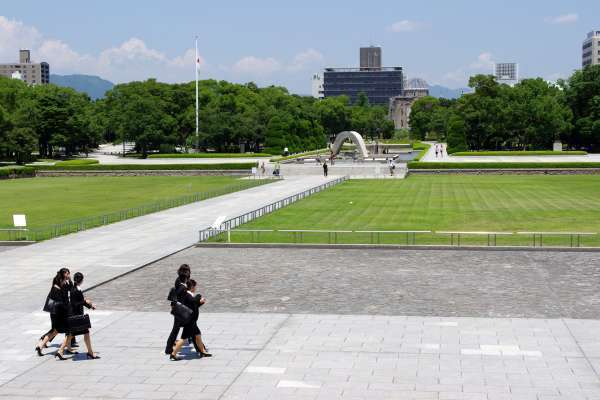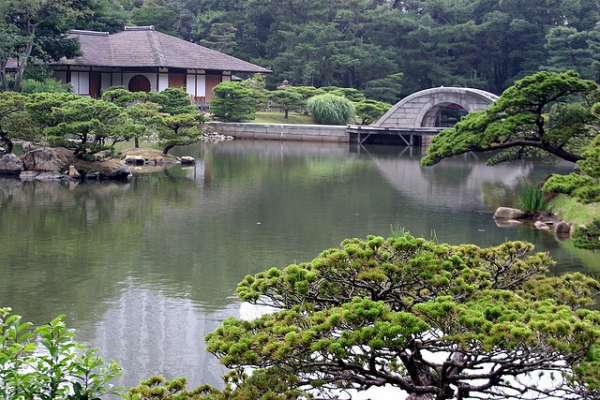A visit to Hiroshima quite often begins with a stroll through Peace Memorial Park. In and around the area of the park are the Hiroshima Peace Memorial Museum, the Hiroshima National Peace Memorial Hall for the Atomic Bomb Victims, and of course, the Atomic Bomb Dome, which stands as a reminder to the world of the horror caused by the atomic bomb. Here are the five must-see places on a trip to Hiroshima:
1. Hiroshima Peace Memorial Museum

(image by flickr.com)
Along with the Atomic Bomb Dome, this is a place for learning about the atomic bombing. Starting merely four years after the atomic bombing, materials related to the damage and suffering caused by the atomic bomb had been exhibited since 1949. Then in 1955, the HiroshimaPeace Memorial Museum was opened. This museum conveys the conditions at the time of the bombing by a wide range of display including explanations of the structure and destructive power of the atomic bomb, explanations of radioactivity, heat rays, the blast, and damages caused by fire, as well as an exhibition of the belongings of the victims. Even visitors of generations with no war experience are certain to receive an intense impact from the exhibited items which include valuable evidences such as a scorched lunch box, a burnt uniform, stone steps marked with a person’s shadow created by the heat rays, and traces of black rain. Visitors are allowed to touch the exhibited heat ray-damaged roof tiles which were melt and rendered into a bubbly form by the massive heat.
Videos of more than 300 victims speaking of their experiences can be viewed at any time. Furthermore, audio guides in 17 languages and pamphlets in 9 languages are available. An exhibition of “Hiroshima’s History in Light of the Atomic Bombing” is displayed at the East Building in which historical facts of Hiroshima from the times before and after the bombing are introduced. The belongings and pictures of victims are exhibited at the Main Building. The museum shop is also located in the Main Building.
Admission: ¥ 50
- Guidebook from Planetyze about Hiroshima Peace Memorial Museum
- Reviews from TripAdvisor about Hiroshima Peace Memorial Museum
- Tours of Hiroshima Peace Memorial Museum
2. Atomic Bomb Dome

(image by upload.wikimedia.org)
The building was designed by a Czech architect Jan Letzel and was opened as a hall for displaying products of Hiroshima Prefecture. It was a modern, three-story brick building with a European architectural design and a characteristic dome. Together with its reflection in the river, this elegant building was considered one of Hiroshima’s scenic spots. However, more than 90% of Hiroshima City’s buildings were blown out or burnt down by the atomic bombing on August 6, 1945. Located only a short distance away from the hypocenter, the building was exposed and damaged entirely by fire but miraculously, it was able to retain most of its structure. Though cracks and other damages of this building–renamed as the Atomic Bomb Dome–progressed in subsequent years, the building underwent a preservation construction project in 1967 which was funded by a total of 66,197,816 yen that had been donated from around the world. Since then, enabled by subsequent donations, preservation construction projects and conservation researches have been conducted twice.
Because the Atomic Bomb Dome is the only building in the world that coveys the horror caused by an atomic bomb in the same state as it was immediately after the bombing, the building was listed as a World Heritage site in 1996 as an unparalleled symbol of peace that appeals for the total abolition of nuclear weapons and speaks of the importance of peace. Though visitors cannot enter the Atomic Bomb Dome since it is fenced off, viewing it from the outside is more than enough to observe the terror of the atomic bomb. On the opposite side of the Atomic Bomb Dome across the Motoyasu River is the Peace Memorial Park, a highly recommended complex for learning about the conditions at the time of WWII. If you are planning to go to Itsukushima shrine at Miyajima, you can take an excursion boat from a stop in front of the Atomic Bomb Dome; the boat will get you there in about 45 minutes.
Admission: Free
- Guidebook from Planetyze about Atomic Bomb Dome
- Reviews from TripAdvisor about Atomic Bomb Dome
- Tours of Atomic Bomb Dome
3. Hiroshima Peace Memorial Park

(image by upload.wikimedia.org)
Hiroshima Peace Memorial Park is on the opposite side of the Atomic Bomb Dome across a river. Praying for eternal world peace, this park was established near the hypocenter of the atomic bomb explosion. A large number of monuments to the atomic bomb victims and peace monuments are set up in the vast grounds of the park. The monument at the center of the park dedicated to the atomic bomb victims is shaped in a form of a house to protect the souls of the victims from rain and wind. When looked at from the front, you can see the Atomic Bomb Dome in the distance just under the “roof” of this house-shaped monument. The engraving on the stone plate inside this monument reads “Please rest in peace; for we shall never repeat the error.” The rock chamber in the center contains 107 booklets that list the names of atomic bomb victims (292,325 people).
The model for the girl of the Children’s Peace Monument is Sadako Sasaki who had been exposed to the atomic bomb radiation at the age of 2 and died of leukemia at the age of 12. Prompted by the suggestion of a young man who found out about Sadako’s death from a newspaper article, funds were raised and this monument was built to commemorate the souls of the children who lost their lives due to the atomic bomb. The Bell of Peace built in the park in 1964 is used every year at the annual Peace Memorial Ceremony held on August 6. Also, it has been selected as one of Japan’s 100 sound-related spots people wish to preserve for future generations. In addition to the annual ringing of this bell, a chime is played every morning at the park at 8:15, the time when the atomic bomb was dropped. The Hiroshima Peace Memorial Museum is also located in this park. This museum collects and displays the belongings of the atomic bomb victims as well as images and materials that depict the horrors caused by the bomb.
Admission: Free
- Guidebook from Planetyze about Hiroshima Peace Memorial Park
- Reviews from TripAdvisor about Hiroshima Peace Memorial Park
- Tours of Hiroshima Peace Memorial Park
4. Hiroshima National Peace Memorial Hall for the Atomic Bomb Victims

(image by ja.wikipedia.org)
Run by the national government, this memorial hall was built to commemorate the atomic bomb victims; it is located within the Hiroshima Peace Memorial Park which was opened in 2002. There is no entrance fee. The display includes the belongings of the victims and videos showing the conditions at the time of the war and the damages caused by the bombing. Also, visitors can view data and images of their interest by using the museum’s computers to search memoirs of victims, videos of testimonies by victims, pictures of Hiroshima before and after the dropping of the bomb, and videos of Hiroshima immediately after the bombing. The memoirs are translated into 18 languages, allowing many visitors to read them in their native language to discover the reality of the suffering caused by the atomic bomb. Also, an English reading session of the memoirs of the atomic bomb victims is held monthly from 14:30 to 15:10 on the second Sunday. No reservation is required to participate in this session.
When you approach the basement floor by walking through the facility counterclockwise, passing by the display in a reversed order back to August 6, 1945, there is the Hall of Remembrance. Displayed at this hall is a panoramic image of the burnt-out ruins of Hiroshima City following the bombing; the image consists of tiles of the same number as the number of the victims who passed away (approx. 140,000). The basin at the center indicates the time the bomb was dropped, 8:15 a.m., and contains water to be offered to the atomic bomb victims who died craving for water. It is a space for commemorating the atomic bomb victims and for contemplating on peace. In the back of this hall is the Victims’ Information Area where pictures and names of the perished victims are displayed. As the surviving victims who tell the story of their experiences after the atomic bombing have become considerably older in recent years, one of the many purposes for building this memorial hall was to preserve the voices of the victims for succeeding generations.
Admission: Free
- Guidebook from Planetyze about Hiroshima National Peace Memorial Hall for the Atomic Bomb Victims
- Reviews from TripAdvisor about Hiroshima National Peace Memorial Hall for the Atomic Bomb Victims
- Tours of Hiroshima National Peace Memorial Hall for the Atomic Bomb Victims
5. Shukkei-en

(image by flickr.com)
A strolling garden around a pond is a style that was often seen in the gardens of feudal lords of the Edo Era. The central Takuei Pond is divided into two parts by Kokokyo Bridge, and approximately 10 islands of varying size, mountains, valleys, teahouses, bridges and arbors are artfully arranged. The path that links all these features together provides the way to see the inside of the garden. Walking along a small path will also reveal places such as a bamboo forest, a paddy field, and a tea field. It is as if all of the Japanese landscapes have been shrunken and pressed into a deep space.
The 8,000㎡ Takuei Pond which is located in the center of the garden is a relaxing spot which attracts fish and water birds. The granite Kokokyo Bridge draws a beautiful arch and is a place that symbolizes Shukkei-en. The arbor, Yuyutei, which faces Takuei Pond has been used since ancient times for events such as evening tea parties and poetry parties. Meigetsu-tei, with its sukiya-style construction and straw-thatched roof, is inconspicuously located in the northwest part of the garden, and becomes even lovelier when surrounded by the beautiful foliage of fall. Geikibou is the highest summit within the garden where you can get a view of Itsukushima Shrine beyond the landscape of Shukkei-en.
During cherry blossom season, there is nighttime illumination. Blossoms of water lily and hydrangea open in the summer which leave a cooling impression. And then there are the colors of autumn. There is also nighttime illumination during the Maple Festival which gives a different atmosphere when compared to the day. In winter, camellia and plum are in full bloom which signal the end of a full year. Periodic tea parties can be participated in by anyone so please feel free to join whenever the flowers are in bloom. Since Shukkei-en is a garden that can be enjoyed anytime during the year, you can view the most beautiful blossoms of that season for all four seasons.
Admission: Adult ¥ 260 / Child ¥ 100
- Guidebook from Planetyze about Shukkei-en
- Reviews from TripAdvisor about Shukkei-en
- Tours of Shukkei-en